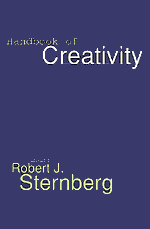Book contents
- Frontmatter
- Contents
- List of Contributors
- Preface
- Handbook of Creativity
- PART I INTRODUCTION
- 1 The Concept of Creativity: Prospects and Paradigms
- 2 A History of Research on Creativity
- PART II METHODS FOR STUDYING CREATIVITY
- PART III ORIGINS OF CREATIVITY
- PART IV CREATIVITY, THE SELF, AND THE ENVIRONMENT
- PART V SPECIAL TOPICS IN CREATIVITY
- PART VI CONCLUSION
- Author Index
- Subject Index
2 - A History of Research on Creativity
Published online by Cambridge University Press: 05 June 2014
- Frontmatter
- Contents
- List of Contributors
- Preface
- Handbook of Creativity
- PART I INTRODUCTION
- 1 The Concept of Creativity: Prospects and Paradigms
- 2 A History of Research on Creativity
- PART II METHODS FOR STUDYING CREATIVITY
- PART III ORIGINS OF CREATIVITY
- PART IV CREATIVITY, THE SELF, AND THE ENVIRONMENT
- PART V SPECIAL TOPICS IN CREATIVITY
- PART VI CONCLUSION
- Author Index
- Subject Index
Summary
The title we have given this chapter is meant to signal to readers that we recognize that the history we describe is one among other possible histories of the same subject. This chapter truly presents a and not the history of research on creativity.
Our attempt to describe the broad and extended historical changes in the concept of creativity can be easily contrasted with efforts to describe the narrower historical changes in actual creativity. Bullough, Bullough, and Mauro (1981), Gray (1966), Kroeber (1944, 1956), Martindale (1992), Naroll et al. (1971), and Sorokin (1947) compared specific historical eras in terms of various indices of creativity. Bullough et al., for instance, compared eighteenth-century Scotland with fifteenth-century Italy. Historical differences in content and abstractness are also implied in studies of Zeitgeist; these assume that there is a “spirit” that is unique to creative eras (Boring, 1929; Simonton, in press).
Additional historical perspectives are involved in studies of eminent creators's developmental background and careers. Although they may not have influenced the meeting of research and creativity, investigations of eminent persons have contributed chiefly to the way we think about creativity (see, e.g., Albert, 1975; Gardner, 1994; Ochse, 1990; Roe, 1952). Our own perspective directed us to the work of eminent individuals (e.g., Francis Bacon, Darwin, Galton, Malthus, and Adam Smith) who had particular impact on the clarification and eventual meeting of the concepts of research and creativity.
Information
- Type
- Chapter
- Information
- Handbook of Creativity , pp. 16 - 32Publisher: Cambridge University PressPrint publication year: 1998
Accessibility standard: Unknown
Why this information is here
This section outlines the accessibility features of this content - including support for screen readers, full keyboard navigation and high-contrast display options. This may not be relevant for you.Accessibility Information
- 15
- Cited by
